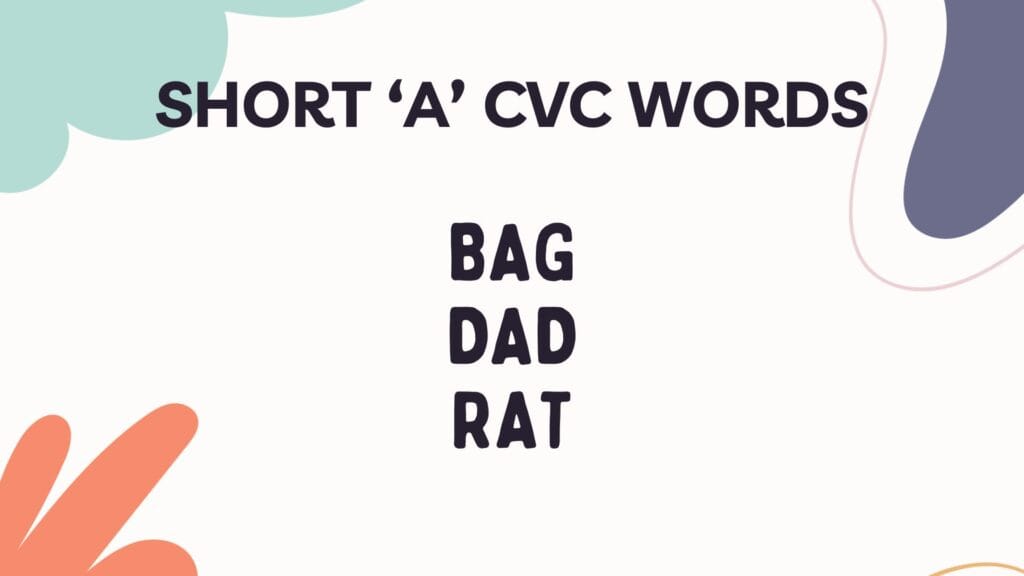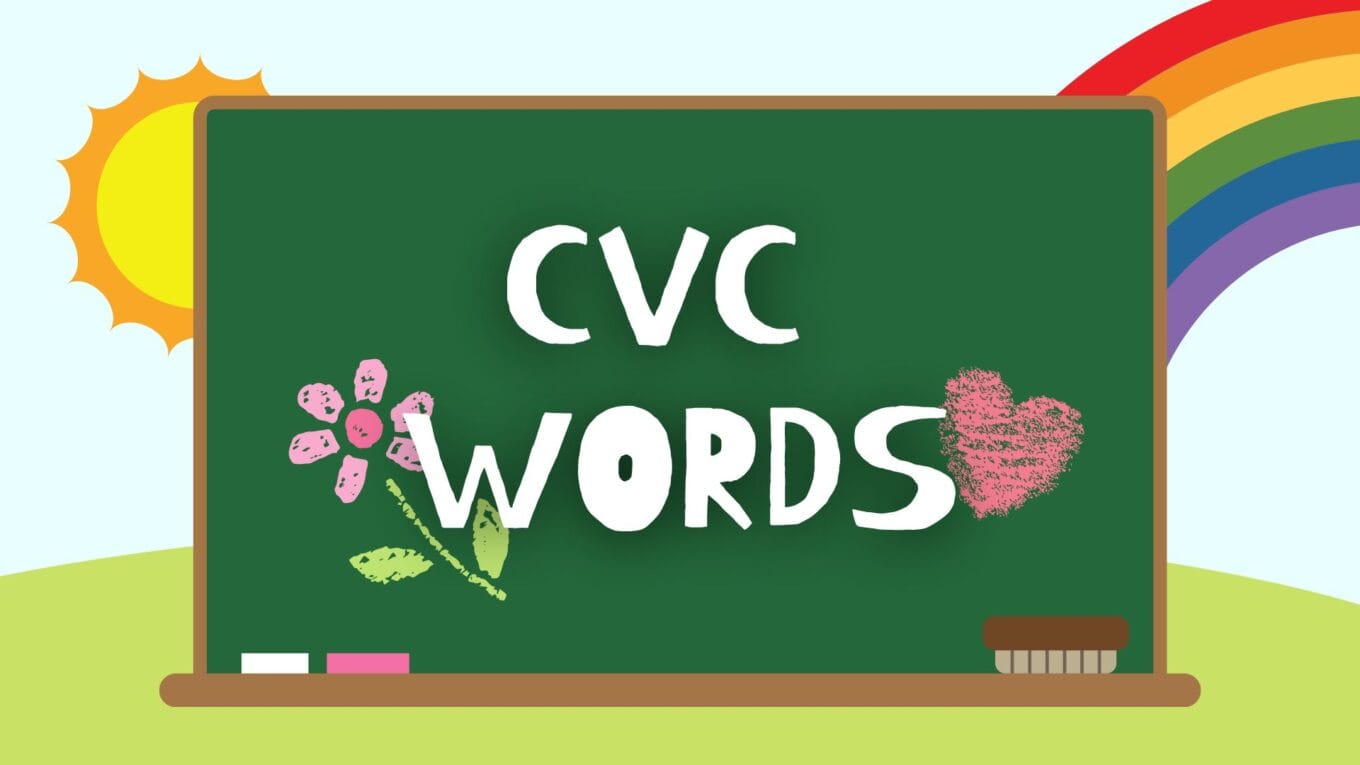Are you trying to help a child learn to read? We know it can be tough. Many parents and teachers struggle to find effective ways to teach reading basics. But don’t worry – we’ve got a simple solution that works wonders.
CVC words are the key to unlocking early reading skills. These easy-to-learn words build confidence and set a strong foundation for literacy.
In this guide, we’ll show you how to use CVC words to make reading fun and achievable for young learners. You’ll discover practical tips and a handy word list to get started right away.
Ready to see your child’s reading skills take off? Let’s jump into the world of CVC words together!
What are CVC Words?

CVC words are simple three-letter words that follow a consonant-vowel-consonant pattern. These words form the building blocks of early reading.
Each letter in a CVC word represents a single sound, making them perfect for teaching basic phonics. For example, in the word “cat,” we hear three distinct sounds: /c/ – /a/ – /t/.
Learning CVC words is a big step for new readers. It helps them blend sounds and read with more ease. Some common CVC words include “dog,” “pan,” “bed,” and “sun.” By mastering these words, kids start to see patterns in language, which boosts their reading skills.
How CVC Words Support Phonics Learning?
CVC words play a key role in teaching phonics. They help children learn how to decode simple words by putting sounds together. This skill is crucial for reading fluently later on.
When kids work with CVC words, they improve their hearing of short vowel sounds. They also learn how consonants work at the start and end of words, which helps them tackle more complex words as they grow.
As children read more CVC words, they start to spot patterns. This makes them feel good about their progress. They begin to trust their ability to sound out new words. This confidence is super important for young readers.
Short Vowel ‘A’ CVC Words List
| Ending | Words |
|---|---|
| -at | cat, hat, bat, mat, rat, sat, pat, fat, vat, chat, flat |
| -an | man, fan, pan, tan, van, ran, plan, scan, clan, bran |
| -ap | cap, nap, tap, lap, sap, map, clap, trap, flap, snap |
| -ag | bag, tag, rag, nag, wag, drag, flag, snag, brag |
| -ad | dad, mad, sad, bad, lad, glad, clad, pad, tad, had |
Short Vowel ‘E’ CVC Words List
| Ending | Words |
|---|---|
| -et | net, wet, pet, jet, vet, let, met, set, get, bet, fret, set |
| -en | hen, pen, ten, men, Ken, den, yen, Ben, when, Glen |
| -eg | leg, peg, beg, Meg, Greg, egg, keg |
| -ed | red, bed, wed, fed, led, shed, bled, fled, shred, sped |
Short Vowel ‘I’ CVC Words List
| Ending | Words |
|---|---|
| -it | sit, hit, bit, fit, lit, kit, pit, grit, knit, slit |
| -in | pin, win, fin, tin, sin, bin, kin, grin, chin, spin |
| -ig | pig, dig, big, rig, wig, twig, fig, jig, zig, gig |
| -ip | lip, sip, tip, dip, rip, flip, slip, trip, clip, grip |
| -id | kid, lid, rid, did, hid, slid, grid, bid, skid, quid |
Short Vowel ‘O’ CVC Words List
| Ending | Words |
|---|---|
| -ot | hot, pot, not, rot, lot, dot, cot, plot, spot, trot |
| -op | mop, top, pop, hop, cop, flop, drop, prop, crop, shop |
| -og | dog, log, fog, jog, hog, clog, frog, smog, blog, slog |
| -ob | job, sob, rob, cob, glob, blob, knob, mob, snob, bob |
| -od | rod, nod, pod, God, sod, cod, plod, prod, trod, odd |
Short Vowel ‘U’ CVC Words List
| Ending | Words |
|---|---|
| -ug | bug, rug, hug, mug, dug, jug, plug, shrug, tug, snug |
| -un | run, sun, fun, bun, gun, pun, spun, shun, stun, nun |
| -ut | cut, hut, nut, but, shut, strut, gut, jut, mutt, rut |
| -ub | cub, tub, sub, rub, scrub, club, shrub, hub, blub |
| -ud | mud, bud, sud, cud, thud, stud, dud, crud, spud, scud |
Activities to Practice CVC Words

1. Phonics Matching Games
Let’s make learning CVC words fun with some cool games! One great way to practice is by playing matching games. These games help kids see and hear CVC words better.
Here’s a simple game: Make cards with CVC words on one set and pictures on another. Ask the child to match the word “cat” with a picture of a cat. This helps them link the word to its meaning.
Another fun game is letter matching. Write CVC words with one letter missing, like “_ at.” Then, have letter cards with “c,” “b,” and “m.” The child picks the right letter to make a word, which helps them understand how sounds work together.
2. CVC Word Family Sorting
Sorting CVC words into groups, or “families,” is a smart way to learn. It helps kids spot patterns in words, which makes reading easier.
Try this: Write CVC words on small cards. Ask the child to group words that sound the same at the end. For example, “cat,” “hat,” and “mat” would go together. “Pig,” “big,” and “dig” would be another group.
This activity shows how changing the first letter can make a new word. It’s a big help for understanding how words are built.
3. Writing Practice
Writing CVC words is a great way to remember how they look and sound. It also helps with spelling and saying the words right.
Here’s a fun writing activity: Draw a simple picture, like a sun. Ask the child to write the word “sun” under it. This connects the word to its meaning.
You can also ask kids to use CVC words in short sentences. For example, “The cat sat.” This helps them understand how to use the words when reading and writing.
These hands-on activities make learning CVC words fun and help the lessons stick. Remember, practice makes perfect!
Conclusion
Let’s wrap up our chat about CVC words. We’ve examined these words and why they’re so helpful for new readers. We’ve also shared some fun ways to practice them.
Remember, CVC words are like stepping stones for kids learning to read. They help build confidence and make reading less scary. You can make learning these words a fun adventure using games, sorting activities, and writing practice.
Every child learns at their own pace, so be patient and keep things playful. With time and practice, you’ll see progress. CVC words are just the start of an exciting journey into the world of reading.
Keep up the good work, and happy reading!




